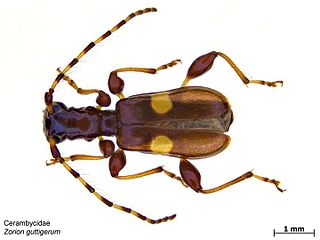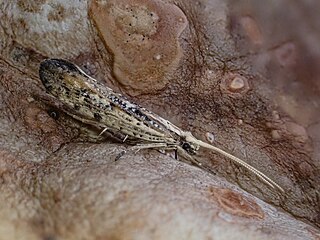
Mecodema is a genus of large flightless ground beetle (Carabidae) endemic to New Zealand. The genus is very diverse in comparison to the other three New Zealand genera within the subtribe Nothobroscina. Mecodema is geographically widespread across both the North and South Islands, as well as numerous offshore islands, including the Three Kings Is., Poor Knights Is., Aotea and Hauturu, Kapiti Is., Stephens Is., Stewart Is., Chatham Is., Snares Is.

Pericoptus truncatus is a large sand scarab beetle. It is native to New Zealand and is found on beaches throughout New Zealand. Its Māori name is ngungutawa.

Izatha prasophyta is a moth of the family Oecophoridae. It is endemic to New Zealand, where it is known from the North Island, except Hawkes Bay or the Wairarapa. Larvae likely feed on rotting wood although larvae of this species have been reared on the fruiting body of the bracket fungus Bjerkandera adusta. Adults are on the wing from November to February.

Heterocrossa gonosemana is a species of moth in the family Carposinidae. It is endemic to New Zealand and is found throughout the country. It inhabits native forest. Larvae feed on seeds and fruit of Griselinia lucida and possibly Griselinia littoralis. They can be extremely active when disturbed. This species overwinters as a pupa, enclosed in a cocoon, underneath its host plant. Adults are on the wing from November until February and can be found during the day resting on lichen covered tree trunks where they are well camouflaged. The adult is nocturnal and is attracted to light.
Rhysodinae is a subfamily in the family Carabidae. There are 19 genera and at least 380 described species in Rhysodinae. The group of genera making up Rhysodinae had been treated as the family Rhysodidae in the past, and subsequent DNA analysis then placed it within Carabidae, where it was sometimes treated as the tribe Rhysodini, but the most recent analyses place it as a subfamily in a clade along with subfamilies Paussinae and Siagoninae, forming a sister to the remaining Carabidae.

Rhyzodiastes is a genus of beetles in the family Carabidae, containing the following species:
Rhyzodiastes burnsi is a species of ground beetle in the subfamily Rhysodinae. It was described by Charles G. Oke in 1932, as Rhysodes burnsi. It is found in New South Wales in coastal zones The type locality is Mount Wilson, New South Wales. Rhyzodiastes burnsi measure 7 mm (0.28 in) in length.
Abacetus emeritus is a species of ground beetle in the subfamily Pterostichinae. It was described by L. Peringuey in 1899. A. emeritus is a small beetle shiny black in colour with reddish mouth feelers and pitchy black legs and antennae. A. emeritus is very rare with only one known published account of collection. Very little is known about its habitat, however it is found in the subtropical highlands of Zimbabwe.

Epichorista aspistana is a species of moth of the family Tortricidae. It is endemic to New Zealand and has been collected in Canterbury and Otago. This species inhabits moist grassy areas at altitudes ranging from sea level to 1650m. Larvae feed on species within the genus Acaena. Adults are on the wing in November to February.

Rhinorhynchus rufulus is a weevil in the Nemonychidae family. It is endemic to New Zealand and was first described by Thomas Broun in 1880. This species is found in both the North, South and Stewart Islands from the sub-alpine zone down to sea-level. Adults can be observed all months of the year. Host plants of this weevil species are conifer trees including Podocarpus nivalis and Lepidothamnus laxifolius.
Scolytus jacobsoni is an elm bark beetle occurring in forests of mixed broad-leaves with elm trees in Asia. In southeastern Russia, during years of outbreaks S. jacobsoni often attacks healthy trees along forest edges or standing alone along roads and in fields and gardens, making it an important pest for elm trees there. Reported hosts include Ulmus davidiana, Ulmus japonica, Ulmus laciniata, Ulmus propinqua, Carpinus betulus, and Pyrus ussuriensis.

Dytiscus semisulcatus, the brown-bellied great diving beetle , is an aquatic diving beetle native to Europe and northern Asia, and is particularly common in England. It is a large dark red-brown or black beetle, that can fly and lives near water.

Saphobiamorpha maoriana is a species of beetle endemic to New Zealand. It was first described by Albert E. Brookes in 1944. It has been collected in the Westland District and in Fiordland.

Hoherius meinertzhageni, the ribbonwood fungus weevil, is an endemic New Zealand beetle that has been recorded feeding on the ribbonwood species Plagianthus regius and Plagianthus divaricatus and the mountain lacebark, Hoheria glabrata.
Palimbolus foveicornis is a beetle in the Staphylinidae family, which is found in New South Wales and Queensland, east of the divide.
Eutassa fuscicollis is a beetle in the Curculionidae family. It was first described by Thomas Broun in 1909, and is endemic to New Zealand

Zorion is a genus of longhorn beetle of the family Cerambycidae that is endemic to New Zealand. About 10 species are currently recognised.

Orthenches chlorocoma is a moth of the family Plutellidae first described by Edward Meyrick in 1885. It is endemic to New Zealand and has been observed in the North and South Islands. The larvae of this species feed on native broom species in the genus Carmichaelia including Carmichaelia australis. Adults are on the wing in September, October and February.

Prodontria longitarsis is a species of flightless beetle in the family Scarabaeidae. This species was first described by Broun in 1909 as Odontria longitarsis. The holotype specimen was collected by George Hudson during the Sub-Antarctic Islands Scientific Expedition and is held at Te Papa.

Scolopterus tetracanthus, more commonly known as the four-spined weevil, is a beetle of the genus Scolopterus. First described by A. White in 1846, it is endemic to New Zealand.














